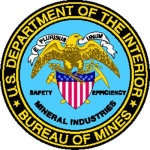- Branża: Mining
- Number of terms: 33118
- Number of blossaries: 0
- Company Profile:
The U.S. Bureau of Mines (USBM) was the primary United States Government agency conducting scientific research and disseminating information on the extraction, processing, use, and conservation of mineral resources.
Founded on May 16, 1910, through the Organic Act (Public Law 179), USBM's missions ...
A clay that has been deposited by water on land, usually in association with rivers or streams.
Industry:Mining
A clay that has been geologically transported from the site of its formation and redeposited elsewhere. The English ball clays, for example, are secondary kaolins. Compare: primary clay.
Industry:Mining
A clay that has been transported from its place of formation and redeposited elsewhere. Compare: residual clay; primary clay. See: sedimentary clay.
Industry:Mining
A clay that is firm when dry at depth but is intersected by cracks through which water will seep easily. Clay deposits of this type are liable to slips on hillside slopes.
Industry:Mining
A clay that is firm when dry at depth but is intersected by cracks through which water will seep easily. Clay deposits of this type are liable to slips on hillside slopes.
Industry:Mining
A clay that, because of its plasticity, serves to bond relatively nonplastic materials in the fabrication of ceramic or other molded products (green bond). Also, a clay that, on firing to furnace or vitrification temperature, bonds adjacent ceramic materials that vitrify at a still higher temperature (fired bond).
Industry:Mining
A clay whose adsorbent character or bleaching action has been enhanced by treatment with acid.
Industry:Mining
A clay, such as bentonite, which, when mixed with water, forms a gelatinous-like liquid.
Industry:Mining
